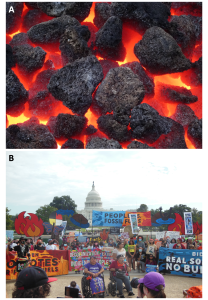Chapter 5 Thermochemistry
Chapter 5 Thermochemistry

Chemical reactions, such as those that occur when you ignite coal, involve changes in energy as well as matter. Societies at all levels of development could not function without the energy released by chemical reactions. While these combustion reactions help us meet our essential energy needs, they are also recognized by the majority of the scientific community as a major contributor to global climate change. In 2023, about 77% of the global energy consumption came from the combustion of petroleum products: coal (25%), oil (30%), and natural gas (22%).[1] Energy in the United States is used in transportation (38%), industrial (35%), residential (15%), and commercial (13%) sectors. Most of the residential and commercial sectors (45% and 52%, respectively) use energy in the form of electricity. In fact, almost 35% of the energy produced in the United States in 2024 went to the electric power sector. Unfortunately, only 41% of the energy in the electric power sector actually results in sales to consumers; the rest is lost as heat while transforming the energy from one type to another or transmitting the energy between the generation site and the point of use. You will learn more about this phenomenon called entropy in Chapter 16.[2]
Useful forms of energy are also available from a variety of chemical reactions other than combustion. For example, the energy produced by the batteries in a cell phone, car, or flashlight results from chemical reactions. This chapter introduces many of the basic ideas necessary to explore the relationships between chemical changes and energy, with a focus on thermal energy.
- Our World in Data. (2025). Global primary energy consumption by source. ↵
- U.S. Energy Information Administration. (2025, July 28). Monthly energy review. ↵
